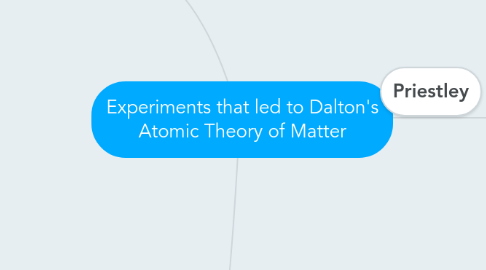
1. Lavoisier
1.1. Heated a mixture of oxygen and phlogiston
1.2. Product that was formed was made of 2 parts phlogiston & 1 part oxygen
1.2.1. Product was later identified by Lavoisier as water
1.2.2. This prompted Lavoisier to rename phlogiston as "hydrogen" which is Greek for "water maker"
1.2.3. Proved that water was a combination of different substances (hydrogen and oxygen)
1.2.3.1. Water was previously thought of as an element
1.3. Demonstrated that the total mass of the reactants & products remained the same before and after the reaction
1.3.1. reactants are the substances that are combined in order to react
1.3.2. products are the substances created from the reaction
1.3.3. We now know this as the "Law of Conservation of Mass"
1.3.4. Basically disproved the previously accepted "phlogiston theory"
2. Diamond/Charcoal Experiment
2.1. Had been known that when a diamond is exposed to extreme heat, it seems to disappear
2.1.1. Later was shown that when diamonds were exposed to extreme heat in an environment free of air, nothing about them changed except that they were really hot
2.2. Heated diamond in presence of oxygen
2.2.1. Gas product was formed and diamond disappeared
2.2.1.1. Gas product was later identified as carbon dioxide
2.2.2. mass of product formed equaled mass of reactants (diamond + oxygen)
2.2.3. Doubling the amount of diamond resulted in consuming twice as much oxygen
2.3. Heated charcoal in presence of oxygen
2.3.1. Results were the exact same as with the diamond
2.3.1.1. This suggested that diamonds and charcoal were made of the same stuff--carbon!
2.4. No matter how big or small the diamond was, it always reacted with the same proportion of oxygen (a 1:1 proportion)
2.5. Determined that elements combine in specific, defined ratios in chemical reactions
3. Priestley
3.1. In a flask, heated red calx which was known to contain mercury
3.2. Upon heating, a pool of mercury remained in flask and a gas was produced and collected
3.3. This new gas proved to ignite glowing splints (help a fire get started) as well as extend the life of a mouse when only breathing this gas in a trapped environment
3.3.1. Identity of the gas was later named oxygen
3.4. His experiment demonstrated that some substances are composed of individual amounts of two or more other substances
3.4.1. In this case, mercury and oxygen
